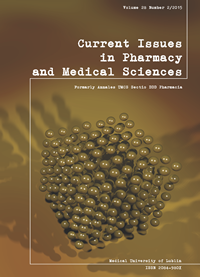Effect of standard and reversible arrangements of Ph.Eur./USP extraction cells during dissolution tests of calcium dobesilate in hydrogel formulation
DOI:
https://doi.org/10.1515/cipms-2015-0060Keywords:
release rate, paddle method, extraction cell, calcium dobesilate, non-ionic polymers, anionic polymersAbstract
The aim of the study was to evaluate, in comparison to the reference product, the effect of the hydrophilic nonionic polymers: methylcellulose (MC) and hydroxypropyl methylcellulose (HPMC), as well as the anionic polymers – copolymers of acrylic acid, on the release kinetics of a calcium dobesilate hydrogel formulation intended for application on the skin. In this work, we used an ointment cell for the release of the active pharmaceutical ingredient (API) from the formulations. This release was performed by employing the paddle method at 100 rpm, with the extraction cells placed in the release vessels in two different positions: with the semipermeable membrane faced to the top, or to the bottom of the vessel. Released API percentage was assessed via the validated spectrophotometric method. In the study with standard placement of the ointment cell, the release rates ranged from 4.45×10-3 min-1 for a formulation containing polyacrylic acid (PA), to 6.96 × 10-3 min-1 for a formulation based on HPMC. In the group of nonionic polymers, the release rate is higher in the case of HPMC, and lower in the case of MC. In the group of anionic polymers, the release rate is higher with the formulation of a modified copolymer of acrylic acid 11 (PC11), while release from a formulation comprising a polymer PA is rather prolonged. We found that the placement of the extraction cell does not affect the alignment of the formulations investigated in terms of the release rates in the group of non-ionic formulations: HPMC > MC, and in the group of preparation of ionic polymers: PC11 > PA.
References
1. Brown W.E., Marques M.R.: USP and Dissolution – 20 Years of Progress. Diss. Technol., 21, 24, 2014.
2. Cuevas P. et al.: Topical dobesilate eye drops for ophthalmic primary pterygium. BMJ Case Rep., doi: 10.1136/bcr.12.2011.5449, 2012.
3. Cuevas P. et al.: Treatment of Stargardt disease with dobesilate. BMJ case Rep., pii: bcr2012007128. doi: 10.1136/bcr-2012-007128, 2012.
4. European Pharmacopoeia 7.0, 2.9.4 Dissolution test for transdermal patches, 01/2008:20904, 2011.
5. Jafferany M. et al.: Geriatric dermatoses: a clinical review of skin diseases in an aging population. Int. J. Dermatol., 51, 509, 2012.
6. Joshi S.C., Lam Y.C.: Modeling heat and degree of gelation for methylcellulose hydrogells with NaCl additives. J. Appl. Polym. Sci., 101, 1620, 2006.
7. Kamath K.R., Park K.: Biodegradable hydrogels in drug delivery. Adv. Drug Deliv. Rev., 11, 59, 1993.
8. Kaur C. et al.: An open trial of calcium dobesilate wit venous ulcers and stasis dermatitis. Int. J. Dermatol., 42, 147, 2003.
9. Lam Y.C., Joshi S.C., Tam B.K.: Termodynamic characteristic of gelation for Methyl – cellulose hydrogel. J. Therm. Anal. Calorim., 87, 475, 2007.
10. Rosiak J., Yoshi F.: Hydrogels and their medical applications. Nucl. Instr. Meth. Phys. Res., 151, 56, 1999.
11. Shah N. et al.: Prediction of Drug release from Hydroxypropyl Methylcellulose (HPMC) Matrices: Efect of Polymer Concentration. Pharm. Res., 10, 1693, 1993.
12. Tejerina T., Ruiz E.: Calcium Dobesilate: Pharmacology and Future Approaches. Gen. Pharmac., 31, 357, 1998.
13. The United States Pharmacopeial convention {711} Dissolution, Stage 6 Harmonization, 2011.
14. Uddin R., Saffoon N., Sutradhar K.B.: Dissolution and Dissolution Apparatus: A Review. Int. J. Curr. Biomed. Pharm. Res., 1, 201, 2011.
Downloads
Published
Issue
Section
License
Copyright (c) 2015 Authors

This work is licensed under a Creative Commons Attribution-NonCommercial-NoDerivatives 3.0 Unported License.


